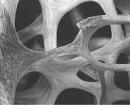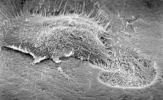
| Home | |
Investigators |
|
 |
|
|
|
||||
GlossaryBones start out as flexible cartilage templates, but before birth this cartilage is mostly replaced by bone, which consists of fine collagen fibres (similar to those present in skin / leather) that are hardened by the addition of large amounts of relatively insoluble calcium and phosphorus salts. This composite structure makes the bone stiff enough to support the body but resistant to fracture. These two key components of bone are illustrated here. Most bones have a more or less solid outer layer, with a honeycomb-like structure in the centre which also contains bone marrow. In the central part of the bones of the skull, spine, shoulder, ribs and pelvis there are special cells that form a reservoir from which replacement blood cells develop. The marrow also contains a reserve of cells that can develop into osteoclasts and osteoblasts. Calcium is an essential part of the mineral component of bone. It occurs in milk and other dairy products but also in tinned fish (the bones are soft enough eat and should not be discarded), nuts, dried fruit and green leafy vegetables such as broccoli. We need around 800 milligrammes of calcium per day - roughly one pint of milk or the equivalent. Women over the age of 50 and those diagnosed with osteoporosis may need to increase their calcium intake by taking supplements. Essential for the absorption of calcium from the intestine. Vitamin D is made in the skin by the action of sunlight and this is the easiest way to ensure the body has sufficient supplies. In sunlight, mild exposure of the skin can make up to 100 micrograms per day. In temperate climates this production ceases in winter and if insufficient Vitamin D isalready stored in the body supplementation from food may become important. Vitamin D occurs in oily fish, eggs and cod liver oil. The body needs between 10 and 20 micrograms per day. Osteoporosis sufferers will usually be prescribed Vitamin D supplements. Coffee and tea adversely affect the uptake of Vitamin D from the intestine. Two types of cells are important in keeping the bone structure intact to withstand the changing stresses on the skeleton. Osteoclasts destroy bone (by excavating pits) and osteoblasts lay down new bone. If the activity of these cells gets out of balance either bone becomes too thin and fragile (osteoporosis) or too thick and heavy (osteopetrosis).
An osteoclast absorbing bone Osteoblasts When bones are fractured the osteoclasts (and other cells) clear up the damaged fragments and osteoblasts then lay down new bone in order to effect the repair. Bone has a much greater capacity to repair itself than cartilage. This is because living bone has a good blood supply (providing nutrients and oxygen), whereas there are no blood vessels in cartilage.
|
||||
| Text only | Accessibility | Search | Contact |
